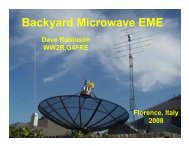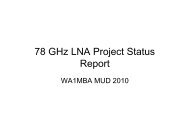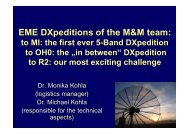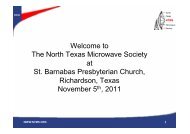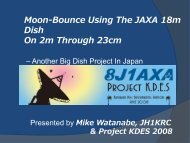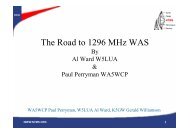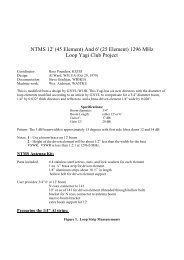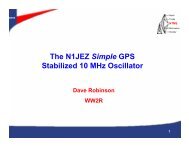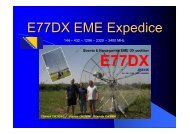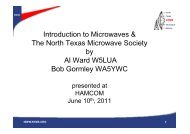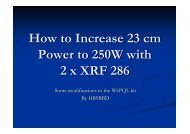G3LTF - NTMS
G3LTF - NTMS
G3LTF - NTMS
You also want an ePaper? Increase the reach of your titles
YUMPU automatically turns print PDFs into web optimized ePapers that Google loves.
Practical Optimization of 432MHz and<br />
up EME systems using VK3UM's<br />
EMECalc Programme<br />
Peter K Blair, <strong>G3LTF</strong>
Content of the Presentation<br />
A short description of EME Calc.<br />
How we got here<br />
Noise measurements<br />
Receiver system issues<br />
Antenna system issues<br />
Antenna adjustments and measurements<br />
Whole system checks<br />
Acknowledgements
EMECalc description<br />
All the elements of the eme link budget, antenna,<br />
Tx power, receive bandwidth,NF for both own and<br />
Dx stations are incorporated into calculations of<br />
received signal level and echo strength<br />
Y factor ratios can be predicted for observations of<br />
sun, moon and radio star sources.<br />
Antenna selection includes yagis and dishes with<br />
a wide range of feed types and f/d ratios.<br />
Validated by measurements by many eme<br />
operators.
Questions, Questions!<br />
W9BIG has the same size dish as me, he just<br />
gave T1NY 559 and I can only truthfully give him<br />
M copy!<br />
How do I know how well my EME system is<br />
working<br />
Am I hearing the weaker stations as well as I<br />
should<br />
Is it the feed, the dish, the preamp, the relay.......
EMECalc can help answer these<br />
questions and guide us to the<br />
solutions.<br />
Squeezing out the last fraction of a<br />
dB of system performance has a<br />
long history.... and has lead to some<br />
amazing discoveries.....
“I still can't account for that last 3.5 degrees<br />
Kelvin....”
Dick Turrin, W2IMU explained how<br />
to evaluate EME systems in his<br />
technical notes, 40 years ago. Add<br />
the work by Paul Wade W1GHZ in<br />
his on-line Antenna book and we<br />
have the core of VK3UM's EMECalc
We will concern ourselves with receive<br />
performance as this is the most difficult to<br />
optimise.<br />
Transmit performance can be derived from Tx<br />
power, transmit feeder loss and antenna gain, G.<br />
For the best receive performance we need to<br />
maximise the ratio G/Tsys<br />
G is the gain of the antenna and Tsys is the<br />
system noise temperature
System Noise Temperature, Tsys<br />
Tsys = Tsky+Tspill +Tft +Trx<br />
Tsky<br />
Sky temperature<br />
Tspill Noise temperature contribution from spillover<br />
Tft Noise temperature contribution from<br />
mesh transparency<br />
Trx Receiver Noise temperature<br />
including feedline loss and following stages
How do we measure G/T<br />
If we point an antenna at a noise source, e.g the<br />
sun, and then away at the cold sky the noise output<br />
of the receiver will change by a ratio Y.<br />
G/Tsys ~ (Y-1)*(freq)^2<br />
F<br />
F is the noise flux of the source. We can use sun,<br />
moon, radio stars.<br />
Measure Y and EMECalc does the calculations
Typical values for G/T for my HB 6m dish<br />
Freq. Actual Theory<br />
432 5 8.7<br />
1296 79 79<br />
2320 133 253<br />
3400 218 543<br />
5760 218 693 (4.5m)<br />
10368 176 2247 (4.5m)
Measuring the Noise Ratio, Y<br />
Wide bandwidth noise receiver with a long<br />
integration time and a power output indicator<br />
plus a calibrated attenuator.<br />
Several good designs in the paper references<br />
You can start off with an audio power meter and<br />
an attenuator.<br />
Spectravue SDR-IQ continuum mode works well.
EMECalc Receiver Section<br />
screen view
Receiver System Issues<br />
Relay and cable losses ahead of LNA.<br />
LNA Noise figure<br />
Effects of following stages<br />
Noise figure estimation using the feedhorn to<br />
measure cold sky to ground ratio, Y, and EMECalc
Noise Figure Estimation using EME Calc.<br />
Connect LNA directly to the feedhorn<br />
Select area with at least 130 degree cone of clear<br />
sky. Beware of local beacons and OOB signals<br />
Point feedhorn to zenith and record noise level.<br />
Point feedhorn at ground several wavelengths<br />
away and record noise level.<br />
Repeat with relay and cable ahead of LNA.<br />
Interpret results with EMECalc
Comments<br />
This is not a precision method but its much better<br />
than guessing.<br />
Keep good notes of what you do.<br />
If you get a weird result there has to be a reason<br />
for it!!<br />
Calibration to a PANFI later will improve your<br />
measurement process.
Antenna System Issues<br />
Choice of feed affects gain and noise temperature<br />
EMECalc contains wide range of feed types<br />
The effect of feed choice and dish parameters can<br />
be fully explored<br />
EMECalc uses the feed analysis results from<br />
W1GHZ on-line antenna book
Antenna Adjustments and Measurements<br />
Adjust feed to set phase centre at the focus<br />
Ensure feed points at dish centre<br />
Measure beamwidth, EME calc provides<br />
corrections<br />
Measure sidelobe levels
Whole System Checks<br />
Measure sun, moon and radio-star noise levels<br />
with Y-factor method.<br />
Make Cold Sky to Ground measurement with dish<br />
Check Cold Sky to 50R load with protection relay<br />
Check echo strengths.<br />
If the result is significantly different from predicted<br />
then there probably is a real problem!
Acknowledgements<br />
Doug Mc Arthur, VK3UM<br />
Paul Wade W1GHZ<br />
And all the many emers who have put in<br />
suggestions and tested and verified the work.



